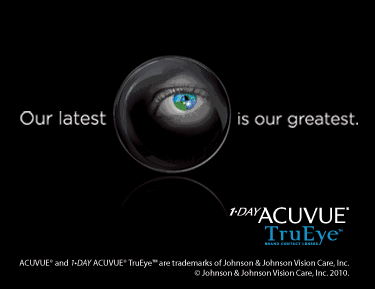|
SynergEyes Expands Parameters for Duette for Astigmatism
SynergEyes, Inc. has expanded the parameters of its new silicone hydrogel hybrid contact lens for astigmatism, Duette. Duette is currently available in limited release in the U.S., at select practices. A nationwide launch began January 1, 2011.
Duette is now available in sphere powers from +4.00D to -12.00D. This expansion in parameters is the first of additional parameter expansions planned for 2011. Because the hybrid platform is rotationally symmetric, Duette is approved to correct up to 6 diopters of corneal astigmatism without having to worry about axis shift, as reported by the company.
The Duette lens features a new SynergEyes-developed GP material, MaxVu and a proprietary Flex2O silicone hydrogel skirt. The high modulus MaxVu GP has a Dk of 130 and incorporates a class II UV blocker, while the low modulus silicone hydrogel skirt has a Dk of 84 and is 32% water. A patent-pending surface treatment, HealthyEyes, increases wettability and resists protein deposits to maximize comfort, according to the company.
For more information, contact SynergEyes at 877-733-2012.
| -- ADVERTISEMENT -- |

|
B+L Extends Crystalens Patient Rebate Program
Bausch + Lomb (B+L) announced that it will extend its "See Better and Save" patient rebate program for patients who have the Crystalens accommodating intraocular lens (IOL) implanted before March 31, 2011. Patients will be eligible for a rebate of up to $250 per eye.
The "See Better and Save" program was introduced by the company last fall. The rebate is available regardless of the patient's choice of physician, hospital or surgical center.
Crystalens is the only FDA-approved accommodating intraocular lens. For more information about the Crystalens, please visit www.crystalens.com.
RegeneRx's RGN-259 Phase 2 Trial Begins
RegeneRx Biopharmaceuticals, Inc. announced that the first patient has been screened and is being enrolled in a Phase 2 clinical trial testing the company's drug candidate RGN-259 in patients with dry eye associated with graft vs. host disease. The double-blind, placebo-controlled, investigator-sponsored trial is expected to enroll a total of 20 patients over the next several months, with data reported later in 2011. RGN-259 is a sterile, preservative-free topical eye drop formulation of the novel therapeutic peptide Thymosin beta 4, or Tβ4.
The clinical trial is being conducted under a physician-sponsored IND in Detroit, Michigan. Steven Dunn, MD, the principal investigator in this study, is an ophthalmologist and corneal specialist who previously treated a group of patients with recalcitrant neurotrophic keratitis with RGN-259. In a group of six such patients, Dr. Dunn reported substantial healing within the treatment period or follow-up. His results have been published in the Archives of Ophthalmology.
Treatment of chronic nonhealing neurotrophic corneal epithelial defects with thymosin beta 4. Dunn SP, Heidemann DG, Chow CY, Crockford D, Turjman N, Angel J, Allan CB, Sosne G. Arch Ophthalmol. 2010 May;128(5):636-8.
Global Specialty Lens Symposium, January 27-30, 2011, Paris Hotel & Casino in Las Vegas

There is still time register for the Global Specialty Lens Symposium! With an expert international faculty and a CE-accredited agenda, the 2011 GSLS will include insightful presentations by experts in the field, hands-on demonstrations of cutting-edge products as well as scientific papers and posters. Look for more detailed information in Contact Lens Spectrum and online at www.GSLSymposium.com.
--ADVERTISING
B+L Appoints Heinick as Corporate Vice President, Global Human Resources and Transformation
Bausch + Lomb (B+L) has named Rick Heinick as Corporate Vice President, Global Human Resources and Transformation.
Mr. Heinick most recently served as a senior partner with Schaffer Consulting, where he advised executives on organizational transformation and people issues. A member of Schaffer's leadership team, Mr. Heinick was an advisor to a number of multinational companies in the health care sector during his 15-year tenure with the firm, including B+L. Other clients included Johnson & Johnson, C.R. Bard, and Schering-Plough.
Prior to Schaffer Consulting, Mr. Heinick was the founder and president of PPS, Inc., a software company focusing on increasing people's performance. He began his career with Mercer Management Consulting.
This month at www.siliconehydrogels.org: Children and contact lenses, myopia progression, use of silicone hydrogels for patients with epidermolysis bullosa, and our synopsis of silicone hydrogels at the 2009 ARVO meeting.
|












